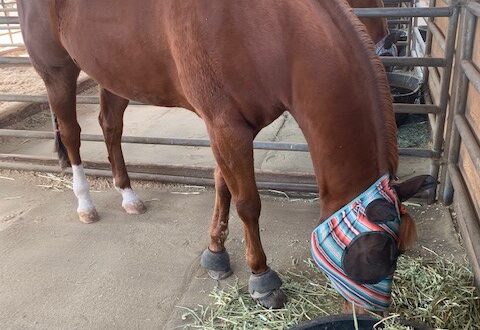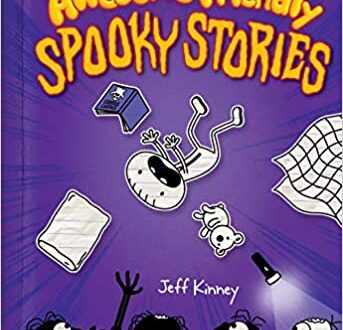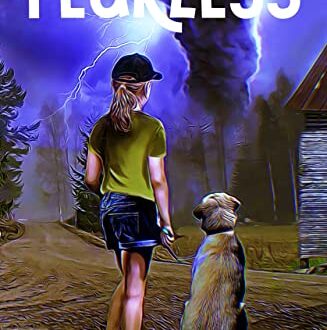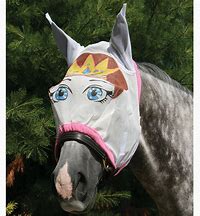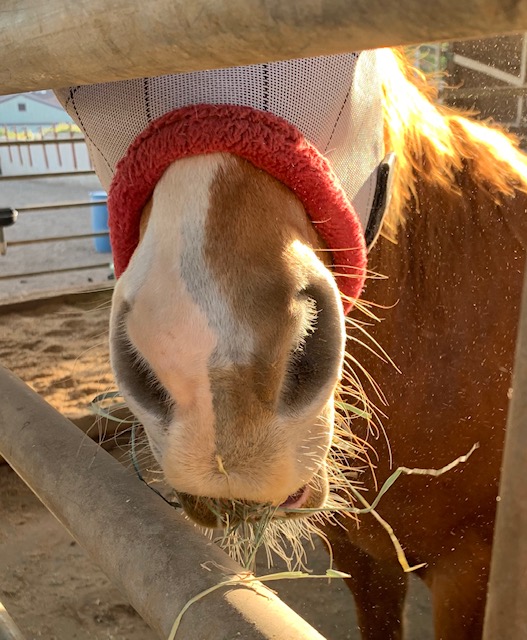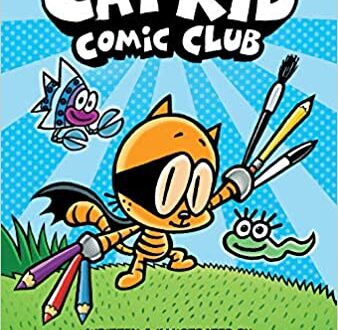-
Kate and the Horses
Kate is used to being alone. When she’s welcomed into the fold by four-legged pals, will her new companions help her find her courage?
Nine-year-old Kate Calloway’s one wish is to finally have a friend. Always struggling to find the right words, the socially awkward bookworm can’t forget the magical day years ago when a carriage horse spoke to her and made her feel special. So, when she unexpectedly sees him on a poster for summer camp, she’s determined to persuade her parents to let her attend and take the reins.
Arriving full of excitement and stumbling upon a stable of talking horses, Kate can’t wait to tell her parents the names of her playmates… while cleverly hiding that they’re not actually human. But when the affectionate animals can’t help her bond with the other kids or avoid a super-mean girl, it’s up to the shy Kate to figure out by herself how to fit in.
Can Kate learn to brave her fears and find love and acceptance?
From author Wendy Ledger for Readers 8-11.
-
Horses in My Blood
I was born with a love of horses. “Horses are in my blood,” is what I like to say. Maybe my DNA? It started with my dad’s parents, and likely earlier than that.
 My grandfather was a Captain in the British Cavalry at the start of the 1900’s, so of course he worked with horses all day, and he enjoyed them. But after his father passed away and the family business burned down, he and rest of the family immigrated to Michigan. Once settled, he met and married my grandmother and continued to love and ride horses. I do wish he could have seen how I’ve carried the family gene on.
My grandfather was a Captain in the British Cavalry at the start of the 1900’s, so of course he worked with horses all day, and he enjoyed them. But after his father passed away and the family business burned down, he and rest of the family immigrated to Michigan. Once settled, he met and married my grandmother and continued to love and ride horses. I do wish he could have seen how I’ve carried the family gene on.My grandmother’s relatives drove stagecoaches and owned a livery stable in New York before moving to Michigan. We’re talking late-1800’s here! Gosh, I wish I’d known them. Imagine driving a stagecoach before other transportation was readily available. Fascinating.
As for me, I loved horses as soon as I could say the word. I grew up with a love of reading every horse book I could find, including The Black Stallion and other books by Walter Farley, also Black Beauty, and others. But I also loved mysteries, and by the time I was ten I started writing my own mysteries featuring a girl and her horse.
My dream of owning a horse came true when I was fifteen. I spent hours trail riding by myself, even in summer when my friends were at the beach. My horse and I often swam in the nearby ponds on hot days, with me riding bareback, holding onto his mane and floating along with him as he propelled us through the water. The only problem was that I had to ride home in stinky and damp clothes! But those were heavenly days.
Since then, I’ve owned and shown horses in Western and English disciplines, and later in Reining and Cattle Sorting. I love spending family time with our Quarter Horses and going on quiet trail rides. It’s so peaceful. I often pretend I’m back in the 1800’s—until a plane flies overhead!
I feel a strong connection to my grandfather whenever I see these two photos together–my grandfather jumping a horse, looking strong and brave, and me making a sliding stop in a Reining competition.
These days, I’m polishing my first manuscript, Out After Midnight, about—what else? A thirteen-year-old girl and her horse, Badger. They’re searching a remote canyon for a missing stallion, and if they don’t find him soon, he won’t be able to win the money needed to save his owner’s ranch!
Yes, horses are in my blood, even when I’m writing.
-
EAT LIKE A HORSE
Have you heard the saying “eat like a horse”?
It often means eating a large volume of food, devouring food or eating fast, helping yourself to someone else’s food, and other (sometimes) unflattering examples, like “making a pig of yourself”. That’s another crazy idiom meaning, among other things, eat too noisily or eat more that your share.
“Eat like a horse” is a contradiction, because for one thing, horses don’t eat fast. Nature built them to walk and graze all day long, snatching mouthfuls of feed here and there. This results in frequent and small meals, keeping their digestive systems moving and healthy.
Now, about eating noisily—when I feed my horses their supplements and their favorite pelleted food, they do eat like pigs!
Topper slobbers and loudly chomps (this despite receiving regular dental care, the slobbering is just plain poor manners). JJ tries to grab the feed bucket before I can get it into his stall, often spilling the contents into his feeder. Can you imagine grabbing your plate from the server at a restaurant, spilling everything on the table? Cappy closes his eyes and savors every bite, like it’s a scrumptious dessert. But don’t get too close to his feed bucket or he will pin his ears at you, clearly saying “Don’t even think about it!”
Truly an example of the three little pigs.
Each of them receive a portion of hay specific to their weight requirements. Still, they shove their hay around with their muzzles, trying to get to what they think are sweeter or more tender bits, and some good amount of their hay gets pushed under their stalls’ pipe rails into their neighbor’s side. So of course, the other horse, let’s say it’s Topper, thinks, “Oh hey! How nice of you. I’ll stop eating my own hay and eat yours instead.” Or, when Cappy’s hay is right on the border of his stall, Topper will try all kinds of contortions to reach it. This includes getting down on his knees, sticking his head under the lowest rail, and stretching his lips and tongue out to snatch any morsel he can, even when there’s plenty of hay in his own stall.
So, I guess I could say, my horses do eat like pigs. Shocking!
On a more serious note, horses’ digestive systems are very sensitive. Horses can get “colic”, which is a term for any type of digestive blockage, indigestion, gas, abdominal pain, etc. Colic can be deadly. Horses can also develop stomach ulcers.
Sudden changes in feed should be avoided, along with foods such as rhubarb, dairy products, potatoes, avocado, lawn clippings (because clippings ferment too quickly), tomatoes and other vegetables, as examples. However, apples and carrots are always welcome, in moderation.
So, is the idiom “eat like a horse” really correct? Or, do horses “eat like a pig”?
What’s really important here is to understand how and what horses should not eat, and to always provide them with good feed appropriate to their nutritional needs, exercise, fresh water, dental care and more.
Check out the internet for more information.
-
Little Sisters and Horses
I was a horse-crazy little sister that always got in the way of my older sister when she wanted to do anything that involved horses. I only sort of felt bad when Mom made them drag me along.
I especially remember one time when my sister, three years older than me, was getting ready to go somewhere. I think I was about seven. I remember because of what happened.
“Where ya’ goin’?” I asked her.
“I’m going to see a horse get shooed.”
Shooed? Why would someone shoo a horse away? Maybe I could catch it when they shooed it. Then it would be mine.
“I want to go too,” I whined.
“No! This is for my Girl Scout Badge. You’re just a Brownie.”
Mom overheard us. “Gayle, you can’t go unless Teresa goes too.”
Gayle huffed. “I don’t see why Teresa has to go everywhere with me.” She stomped her feet and headed for the door.
I ran after her, out the door and down the street.
To my surprise we ended up at my friend’s house. Holly was the luckiest girl in the world because her family had two horses, right in their own backyard! My family had a pool, and everyone said I was lucky, but I would’ve traded my pool in a minute for a horse.
I traipsed after Gayle all the way back to the horse barn. She walked fast and I could barely keep up.
A man had one of Holly’s horses tied up by his truck. It was Penny Boy, a palomino gelding with big brown eyes and a sweet face. My favorite.
Gayle joined her Girl Scout friends gathered near Penny Boy, said something, then they looked at me and giggled, while I stayed by myself, ready to burst into action whenever someone shooed the horse. Where is that horse anyway? I fidgeted in the hot sun.
Clang, clang, clang. The man banged a hammer on some big old iron thing set up by his truck. He held up something metal up in the air, squinting at it, then nodded his head before walking over to Penny Boy. He picked up one of Penny Boy’s front legs and held the metal thing against the bottom of his hoof.
I trotted over to Gayle and whispered. “When are they going to shoo the horse? What horse are they going to shoo anyway?” There were only Holly’s two horses there and I was pretty sure she wouldn’t shoo either of them.
Gayle looked at me like I was a creature from Mars. “That’s what he’s doing. He’s shooing Penny Boy now.”
“But why are they shooing Penny Boy? Don’t they want him anymore?”
Again, the look from my sister. “No—they are putting shoes ON him. See, that man is the shoer, and that’s a horseshoe he’s putting on Penny Boy.”
Thud, thud, thud. The man hammered the shoe onto Penny Boy’s hoof.
Ouch! I moved closer to see if it hurt Penny Boy.
“Teresa,” Gayle said, “he puts the nails into the hoof wall. That’s the outer part of the hoof. It’s just like our fingernails. It doesn’t hurt when Mom clips your nails, right? So, Penny Boy doesn´t feel any pain when the nails get hammered into the hoof wall.”
“Oh, so that’s what you meant when you said a horse was getting shooed today?” My heart and my hopes were shattered, as only a seven-year-old’s can be.
There were a few titters among the older girls. One of them spoke up. “Well, actually it’s called getting ‘shod’. That’s what we’re learning today. And that man is a farrier.”
“Oh.”
I never did get to catch a shooed horse that day. But I did learn a lot, and I had many wonderful adventures with Penny Boy in the years ahead. But that’s another story.
-
JJ – the Heart Doctor
My horse is a heart doctor.
“What?” you may ask of me, and perhaps look askance, wondering if I need a different kind of doctor.
But all us Equestrians know about the healing that horses provide. When we get together at least one of us talks about how our horses are better therapy than seeing a counselor. The rest of us nod our heads and sometimes add our own stories.
“Anytime I’m around my horse, I just feel better,” a friend agrees. “I feel at peace with the world.”
That’s a big statement these days when any number of events can stress us out.
Here’s an example. My mom and dad, definitely not “horsey people”, lived with me for a few months. Mom amazed me one evening when she said, “You know, when you get home from the barn you’re a completely different person. You’re more relaxed, less frazzled from work. You just look happier.”
I knew it was true, but for Mom to see it? Well, I suddenly felt like she finally understood what had been driving me from the day I could say, “Look—horsey!”
So, is this why horses are used for therapy for all ages of children and adults with disabilities or challenges of any kind? Yes, and there’s plenty of information on the internet to read about our wonderful equine partners.
Recently a writer-friend asked if it was possible in the real world for a horse to help slow a human’s heartbeat, or calm a human. She asked because I’m writing a book featuring a thirteen-year-old girl who turns to horses for emotional comfort. She’s grieving and feels abandoned, but when she’s with her horse—and he’s her best friend—her heart rate slows and her anxieties melt away. At least for a while.
I knew the answer to my friend’s question, of course, because my horses are my go-to guys when I’m stressed, and all other times too.
But I typed her question in a search of the internet to see what information was out there.
“Are horses’ heartbeats soothing to people?” I typed. Here’s one of the links that came up, and it’s an excellent article.
HeartMath | Horses & Humans Healing | Tao of Horsemanship
According to this article, a human’s heart energy encompasses a sphere-like area around our bodies, about ten feet. But a horse’s heart energy field is five times larger than ours, and can indeed influence our own heart rhythm!
In fact we only need to be in the general vicinity of a horse to feel that sense of calm and peace. Interacting with horses lowers our blood pressure and our heart rate, decreases stress levels and decreases anger, tension, etc.—whatever we were feeling before we got near the horse’s energy field.
Recently one of my dear friends suffered a terrible loss. I invited her over and we started brushing our horses. She spent two hours hugging, brushing and talking with JJ, my eight year-old gelding. Sometimes he can be a stinker but he was calm and loving with her. By the time she left she was at peace and talking about what wonderful therapy JJ provided. She’s been over to visit him many times after that.
I hope readers will explore the internet to learn more about the healing abilities of horses, and how they help people of all ages learn trust and affection, responsibility and confidence, among other wonderful attributes. Here’s another link to help readers get started. Happy reading!
-
Little Sisters and Horses
I was a horse-crazy little sister that always got in the way of my older sister and brother when they wanted to do anything that involved horses. I only sort of felt bad when Mom made them drag me along.
I especially remember one time when my sister, nearly three years older than me, was getting ready to go somewhere. I think I was about seven. I remember because of what happened.
“Where ya’ goin’?” I asked my sister.
“I’m going to see a horse get shooed.”
Shooed? Why would someone want to shoo a horse away? Maybe I could catch it when they shooed it. Then it would be mine.
“I want to go too,” I wheedled.
“No! This is for my Girl Scout Badge. You’re just a Brownie.”
Mom overheard us. “You can’t go unless Teresa goes too.”
My sister huffed and puffed. “I don’t see why Teresa has to go everywhere with me.” She stomped her feet and headed for the door.
I ran after her, out the door and down the street.
To my surprise we ended up at my friend’s house. Holly was the luckiest girl in the world because her family had two horses, right in their own backyard! My family had a pool and everyone said I was lucky, but I would’ve traded in a minute for a horse.
I traipsed after my sister back to the horse barn. A man had one of Holly’s horses tied up by his truck. It was Penny Boy, a palomino gelding with big brown eyes and a sweet face. My favorite.
My sister joined the group of her Girl Scout friends gathered near Penny Boy, said something, then I heard them giggle. I stayed by myself, ready to burst into action whenever someone shooed the horse. Where is that horse anyway? I fidgeted in the hot sun.
Clang, clang, clang. The man banged a hammer on some big old iron thing set up by his truck. He held up something metal up in the air, squinting at it, then nodded his head before walking over to Penny Boy. He picked up one of Penny Boy’s front legs and held the metal thing against the bottom of his hoof.
I trotted over to my sister and the other girls. I whispered, “When are they going to shoo the horse? What horse are they going to shoo anyway?” There were only Holly’s two horses there and I was pretty sure she wouldn’t shoo either of them.
My sister looked at me like I was a creature from Mars. “That’s what he’s doing –he’s shooing Penny Boy now.”
“But why are they shooing Penny Boy? Don’t they want him anymore?”
Again, the look from my sister. “No—they are putting shoes ON him. See, that man is the shoer, and that’s a horseshoe he’s going to put on Penny Boy.”
Thud, thud, thud. The man hammered the shoe onto Penny Boy’s hoof.
Ouch! I moved closer to see if it hurt Penny Boy.
“Teresa,” my sister said, “he puts the nails into the hoof wall—that’s the outer part of the hoof. It’s just like our fingernails. You don’t hurt when Mom clips your nails, right? So Penny Boy doesn´t feel any pain when the nails get hammered in the hoof wall.”
“Oh, so that’s what you meant when you said a horse was going to get shooed today?” My heart and my hopes were shattered, as only a seven-year-old’s can be.
There were a few titters among the older girls. One of them spoke up. “Well actually it’s called getting ‘shod’. That’s what we’re learning today. And that man is a farrier.”
“Oh.”
So I never did get to chase after a shooed horse that day. But I did learn a lot, and I had many wonderful adventures with Penny Boy in the years ahead.
-
Eat Like A Horse
Have you heard the saying “eat like a horse”?
It often means eating a large volume of food, devouring food or eating fast, helping yourself to someone else’s food, and other (sometimes) unflattering examples, like “making a pig of yourself”. That’s another crazy idiom meaning, among other things, eat too noisily or eat more that your share.
“Eat like a horse” is a contradiction, because for one thing, horses don’t eat fast. Nature built them to walk and graze all day long, snatching mouthfuls of feed here and there. This results in frequent and small meals, keeping their digestive systems moving and healthy.
Now, about eating noisily—when I feed my horses their supplements and some small form of pelleted food, they can eat like pigs!
 My dun horse slobbers and loudly chomps (despite receiving regular dental care—the slobbering is just plain poor manners). My 8-year old gelding tries to grab the feed bucket before I can get it into his stall, often spilling the contents onto the flooring. Can you imagine grabbing your plate from the server at a restaurant, spilling everything on the table? My retired reiner closes his eyes and savors every bite, like it’s a scrumptious dessert. But don’t get too close to his feed bucket or he will pin his ears at you, clearly saying “Don’t even think about it!”
My dun horse slobbers and loudly chomps (despite receiving regular dental care—the slobbering is just plain poor manners). My 8-year old gelding tries to grab the feed bucket before I can get it into his stall, often spilling the contents onto the flooring. Can you imagine grabbing your plate from the server at a restaurant, spilling everything on the table? My retired reiner closes his eyes and savors every bite, like it’s a scrumptious dessert. But don’t get too close to his feed bucket or he will pin his ears at you, clearly saying “Don’t even think about it!”Truly an example of the three little pigs.
Each of them receive a portion of hay specific to their weight requirements. Still, they shove their hay around with their muzzles, trying to get to what they think are sweeter or more tender bits, and some good amount of their hay goes flying into their neighbor’s stall, under the pipe rails. So of course, the other horse, let’s say it’s Topper, thinks, “Oh hey! How nice of you. I’ll stop eating my own hay and go eat yours.” Or, if Topper’s hay lands just inside his stall, his neighbor will try all kinds of contortions to reach Topper’s hay. This includes practically getting down on their knees, sticking their heads under the lowest rail, and stretching their lips and tongues out to snatch any morsel they can—even when there’s plenty of hay in their own stall.
So I guess I could say, my horses do eat like pigs. Shocking!
On a more serious note, horses’ digestive systems are very sensitive. Horses can “colic”, which is a term for any type of digestive blockage, indigestion, gas, abdominal pain, etc. Colic can be deadly. Horses can also develop stomach ulcers.
Sudden changes in feed should be avoided, along with foods such as rhubarb, dairy products, potatoes, avocado, lawn clippings (because clippings ferment too quickly), tomatoes and other vegetables, as examples. However, apples and carrots are always welcome, in moderation.
So, is the idiom “eat like a horse” really correct? Or, do horses “eat like a pig”?
What’s really important here is to understand how and what horses should not eat, and always provide them with good feed appropriate to their nutritional needs, exercise, fresh water, dental care and more.
Check out the internet for more information.
-
THE WATERHOLE
My body glided effortlessly through the green-tinged water, my legs floating over the back of my golden horse, Penny Boy. His ivory white mane drifted alongside his neck, and I grasped a handful of the soft strands so as not to float away and be left behind. I could feel the movement of each of his legs as they rhythmically propelled us across the swimming hole. I looked back over my shoulder just enough to see his white tail streaming behind us, rippling water marking our progress.
It was the closest thing to feeling weightless, to stopping time, not having to think about anything—just feel peace, and relish the trust and companionship between me and Penny Boy, and tell him how much I loved him.
All too soon, the water became shallow and hooves met sand. My hips and legs settled back into place on Penny Boy’s back as we emerged, water streaming down our shoulders, sides and legs, and dripping from Penny Boy’s mane and tail. I knew my cut-off shorts and t-shirt would smell like pollywogs once I got home, but I hardly cared.
Looking back now, I’m amazed that Penny Boy never stopped to shake the water off his body. It’s hard enough to stay on with a saddle when a horse shakes, but bareback—well, maybe I would have stayed on. But no matter. Those were the days when I could mount up Indian-style, grabbing a handful of mane and swinging my leg over Penny Boy’s back, pulling myself into place while he stood patiently.
And now, after all these years, I can still close my eyes and—I’m back at the swimming hole, floating weightlessly and carefree above Penny Boy’s back, a fistful of soft wet mane in my hands, pollywog smell tickling my nose, and whispering to Penny Boy how much I love him.
-
Why are those horses blindfolded?
“I’m worried about the horses in a pasture near me. They’re blindfolded and I’m afraid they’re going to get hurt.”
Every Spring my friend, who works for an animal services department, receives complaints like this!
Do you know what these “blindfolds” really are?
Good job if you know these are actually fly masks, and they don’t impair a horse’s vision. In fact, they protect horses. The masks are made of see-through mesh that protects horses’ face, ears and eyes from flies, insects, and bugs as well as dust and debris in the air and twigs or branches that might otherwise poke them in their eyes.
Fly masks also protect wounds on horses’ heads. Our seven-year old gelding scraped a large spot of hair and skin off his forehead. We doctored his wound and put the fly mask on, protecting him from flies that would otherwise have a party on that wound. Flies are crazy like that.
Have you ever put a fly mask over your own face? I have, and it’s just like looking out your screen door or window screen. Of course my neighbor wanted to know why I was wearing one!
My horses love their fly masks. The minute they see their masks in my hand they lower their heads and stick their noses forward so all I need to do is make sure the opening for their ears is in the right place and then I fasten the Velcro straps.
We always make sure their eyes and faces are clean first, and we make sure to keep their fly masks clean.
Fly masks come in many fun and colorful styles, including coverage for horses’ ears, some have nose fringe, UV protection and longer nose pieces to prevent sunburn. There’s quite a bit more information on the internet about fly masks and their many uses. Just don’t let your neighbor catch you testing one out by wearing it, because take it from me, it might be hard to explain!
-
Whiskers and Horses
Do horses have whiskers?
Oh yes, around their mouth, nostrils and eyes. Whiskers are sensory organs with their own nerve and blood supply. They provide sensory information that helps protect horses, helps them navigate their world—for instance, in the dark, whiskers help prevent them from bumping into things and injuring themselves—and even helps them while they graze. They are very much like an extra set of eyes, or hands.
For instance, horses use the whiskers on their muzzle (mouth and nose) to tell them how close their lips are to water. You’d think that if the water is right in front of a horse’s nose or eyes she could see it, right? Wrong!
Here’s why. Horses are prey animals. That means that Nature placed their eyes on the sides of their heads, giving them almost a complete view of everything around them—except right in front of their face and nose.
When a horse lowers her nose to investigate something new, people might think she is smelling the object, and if her nostrils are flared, she might be. But she’s also using her whiskers to receive special signals that help her figure out what it is, including information about texture and temperature.
Have you ever tried to look down and see your own lips? That’s pretty hard for most people to do, and that’s what it’s like for horses when they look down their nose. I bet you tried it just now!
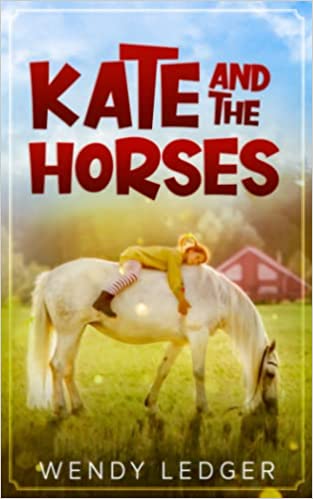


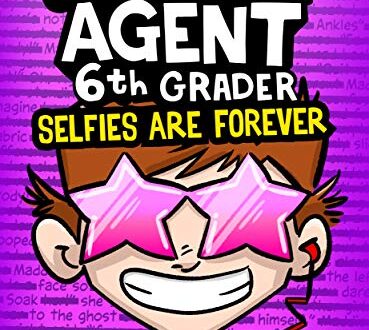

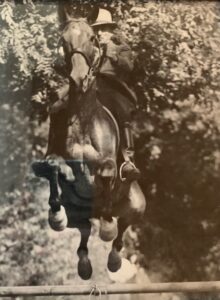 My grandfather was a Captain in the British Cavalry at the start of the 1900’s, so of course he worked with horses all day, and he enjoyed them. But after his father passed away and the family business burned down, he and rest of the family immigrated to Michigan. Once settled, he met and married my grandmother and continued to love and ride horses. I do wish he could have seen how I’ve carried the family gene on.
My grandfather was a Captain in the British Cavalry at the start of the 1900’s, so of course he worked with horses all day, and he enjoyed them. But after his father passed away and the family business burned down, he and rest of the family immigrated to Michigan. Once settled, he met and married my grandmother and continued to love and ride horses. I do wish he could have seen how I’ve carried the family gene on.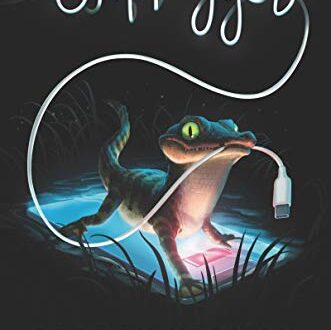
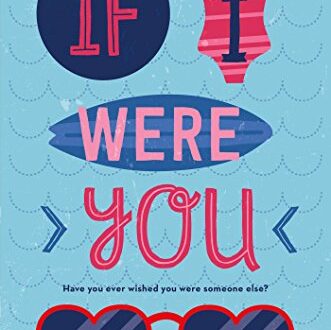
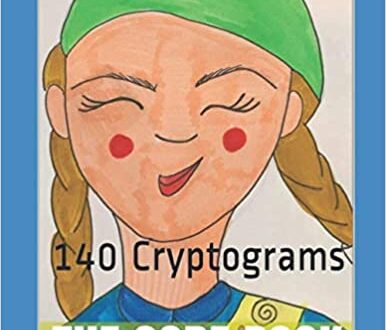
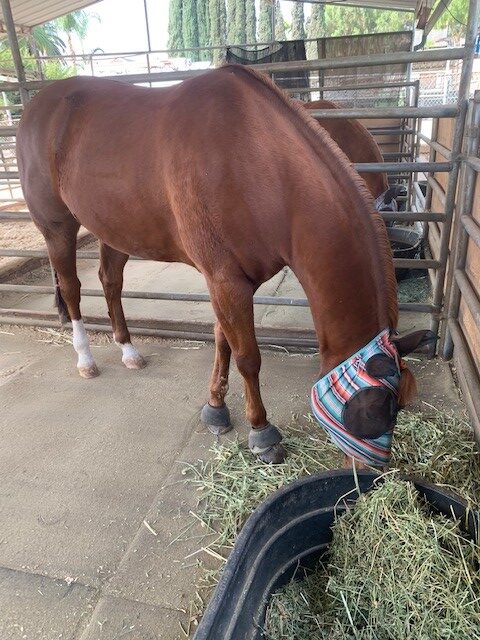

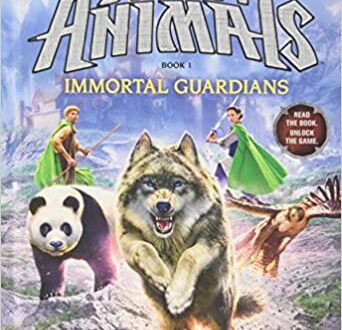

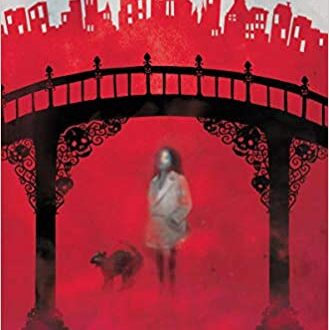

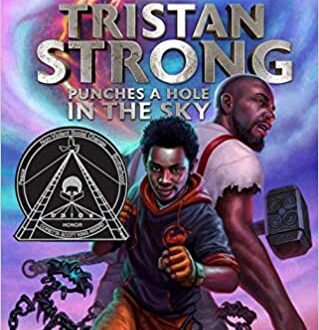
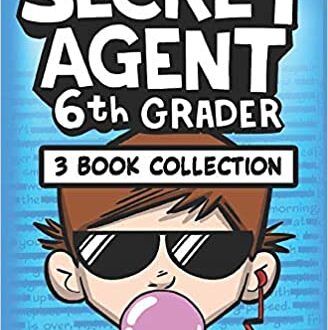

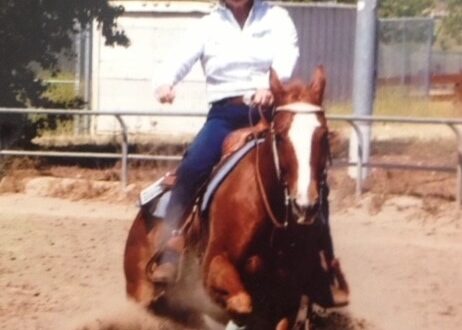
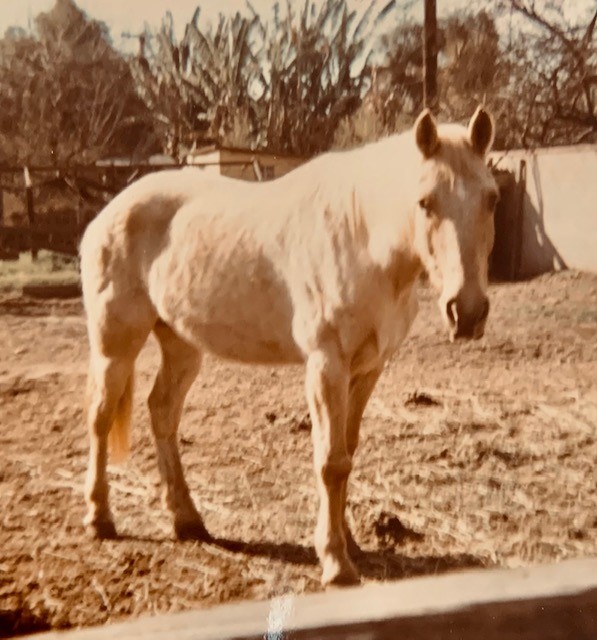

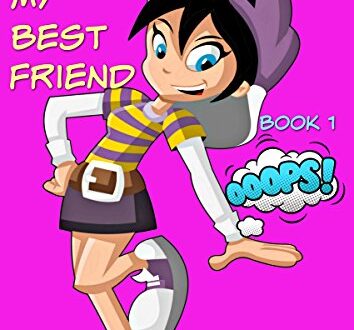
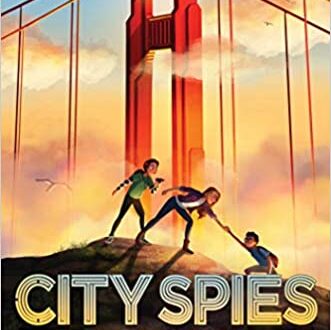

 My dun horse slobbers and loudly chomps (despite receiving regular dental care—the slobbering is just plain poor manners). My 8-year old gelding tries to grab the feed bucket before I can get it into his stall, often spilling the contents onto the flooring. Can you imagine grabbing your plate from the server at a restaurant, spilling everything on the table? My retired reiner closes his eyes and savors every bite, like it’s a scrumptious dessert. But don’t get too close to his feed bucket or he will pin his ears at you, clearly saying “Don’t even think about it!”
My dun horse slobbers and loudly chomps (despite receiving regular dental care—the slobbering is just plain poor manners). My 8-year old gelding tries to grab the feed bucket before I can get it into his stall, often spilling the contents onto the flooring. Can you imagine grabbing your plate from the server at a restaurant, spilling everything on the table? My retired reiner closes his eyes and savors every bite, like it’s a scrumptious dessert. But don’t get too close to his feed bucket or he will pin his ears at you, clearly saying “Don’t even think about it!”
